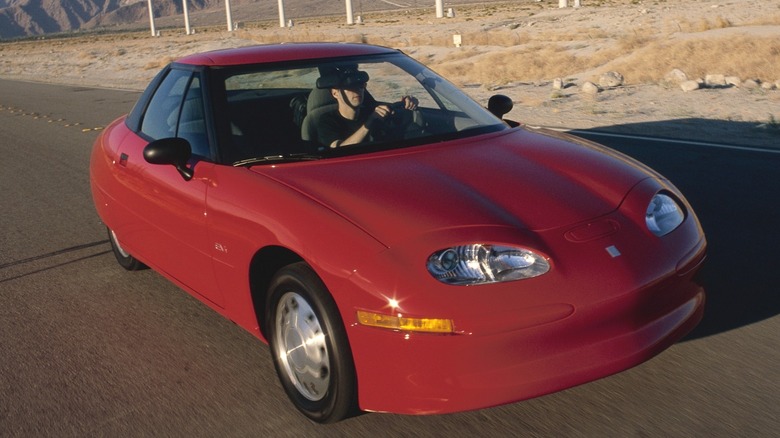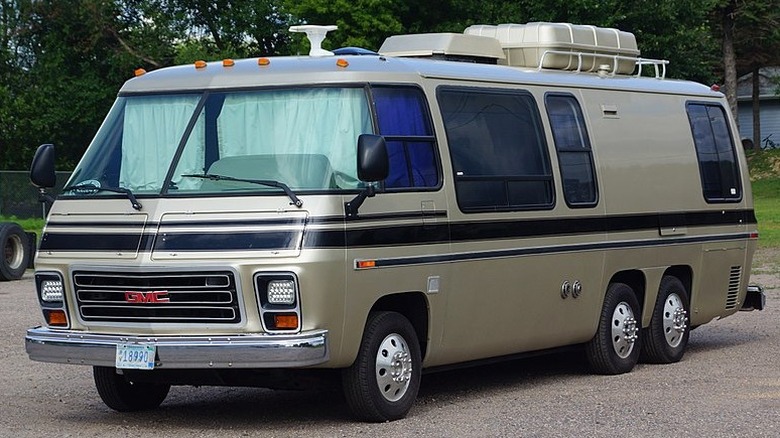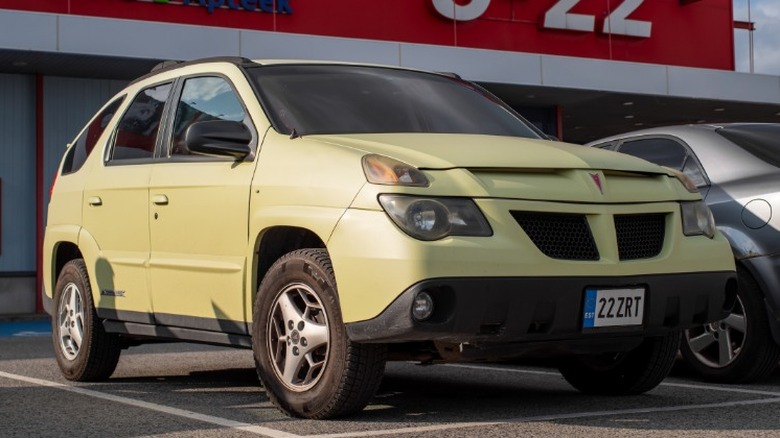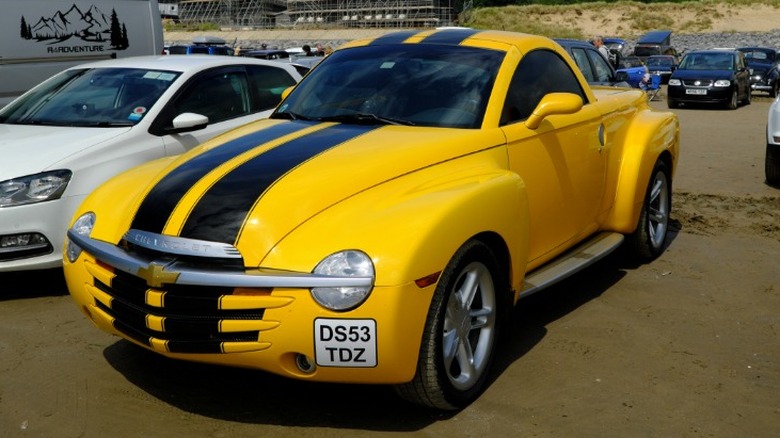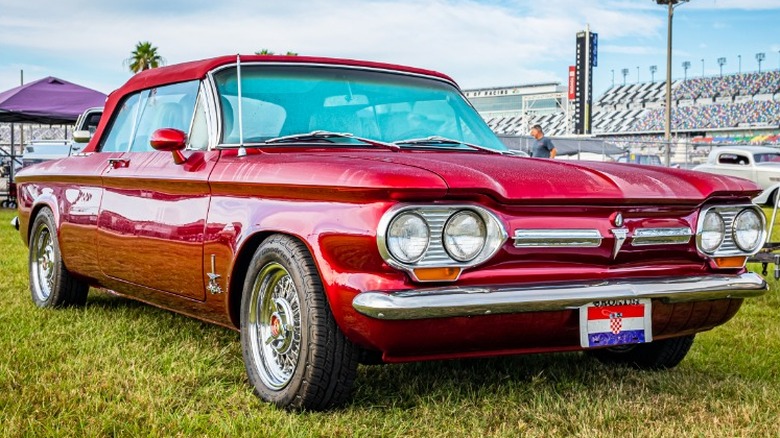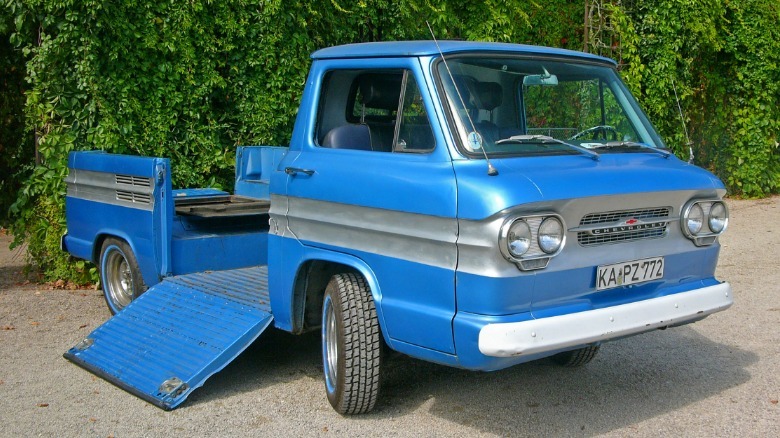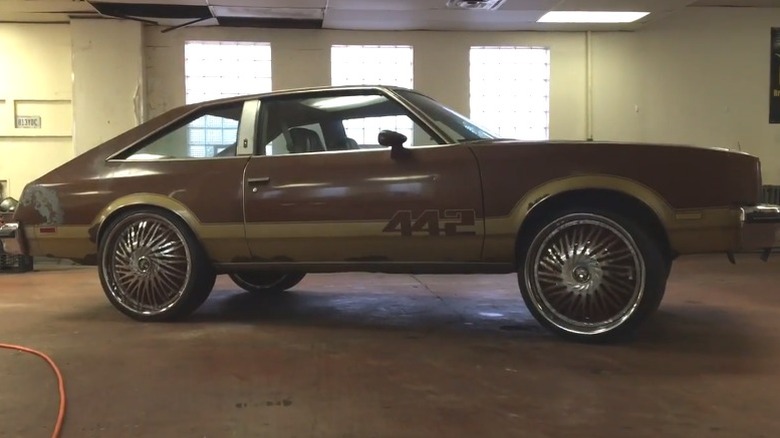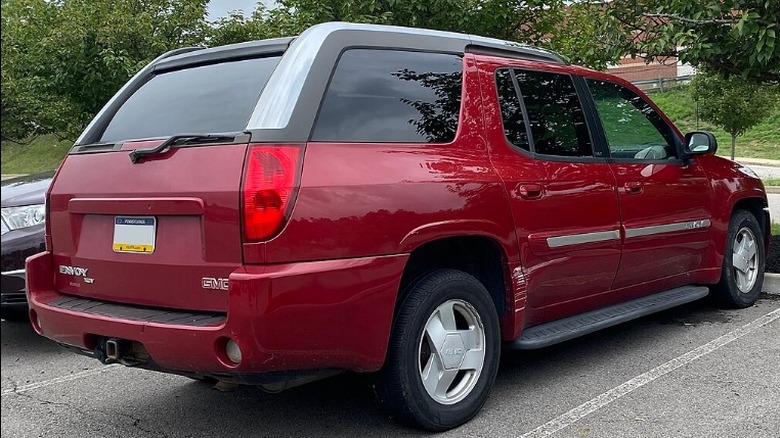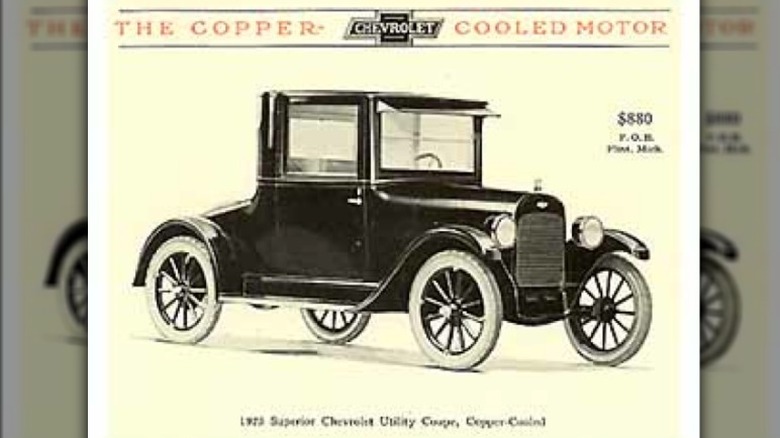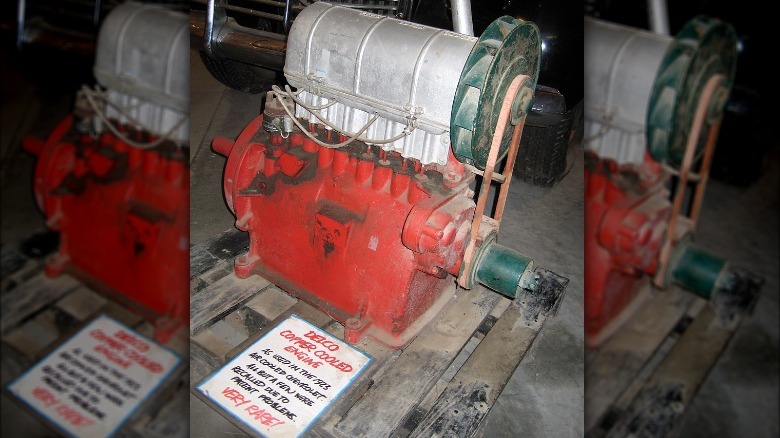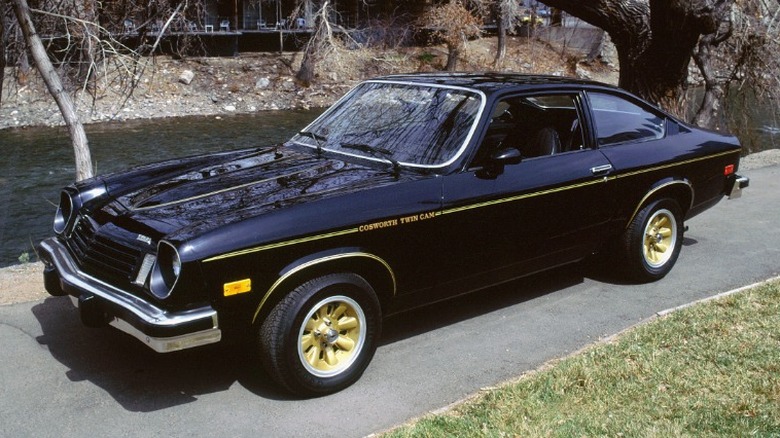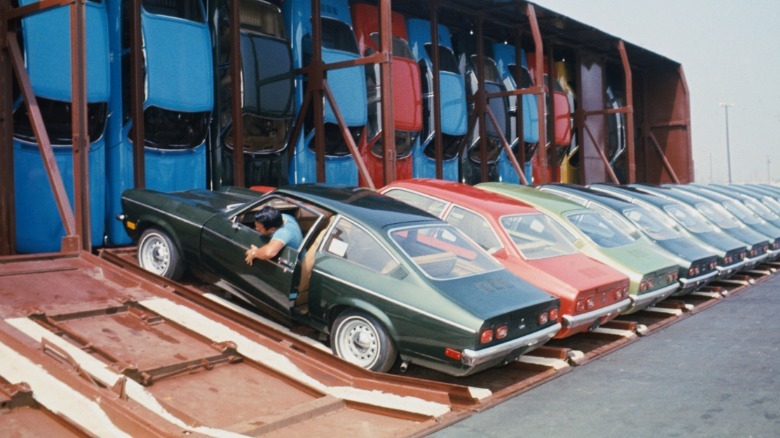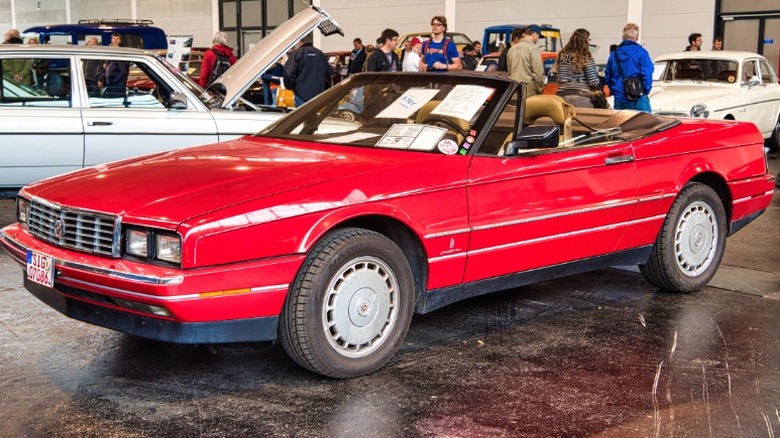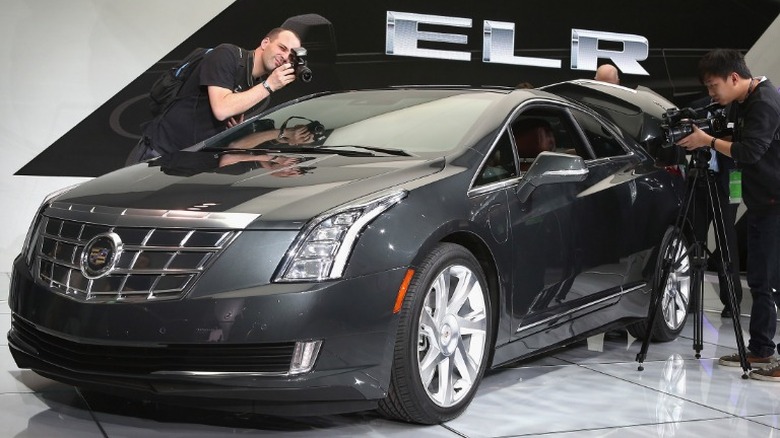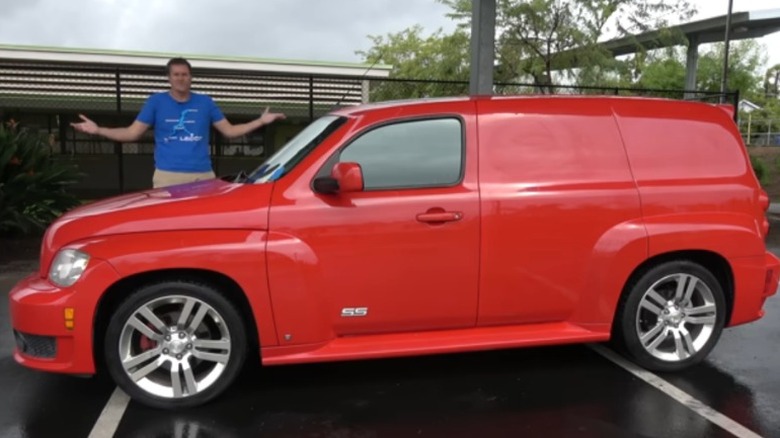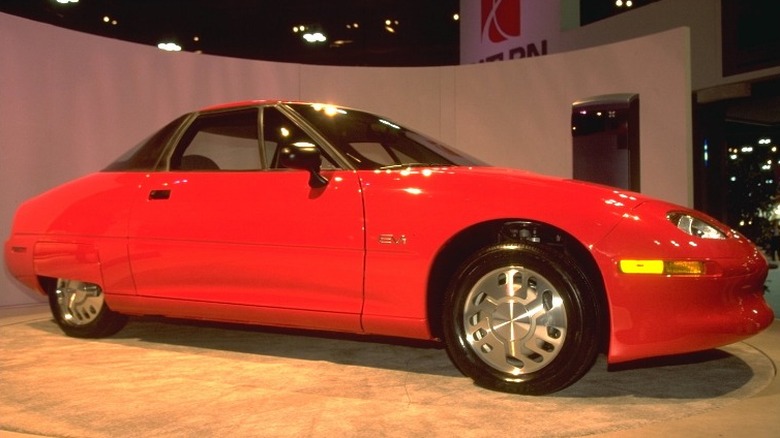12 Of The Strangest Cars Ever Built By General Motors
General Motors was founded in 1908 and quickly merged several auto brands into a huge corporation. Over the years, GM has owned or controlled up to 43 brands of automobiles with manufacturing facilities in nations all over the globe. This Detroit-based behemoth has produced hundreds of models, many of them becoming beloved classics. Some have even become American icons and symbols of prosperity. However, nobody can do everything right every time, and some GM products leave buyers scratching their heads.
Classifying a strange car is subjective. Sometimes seeing a model not sold in your home market can appear strange even though it's an ordinary car in every other way. Other cars are considered strange because of unorthodox styling, with the arrangement of seating, wheels, or trunks executed in an unusual manner. Additional cars may look like typical family cars or even cool and attractive sports cars but are deemed strange for novel engineering choices in the drivetrain or suspension. This is all to say that, for all the excellent Corvettes, Rivieras, and Tran Ams born from GM factories, some models that have made it to dealer showrooms are genuinely strange.
GMC Motorhome
While a motorhome is generally not considered a car, the model made in the '70s by GMC is much more closely related to them than one might think. GM began work on this project in the late '60s with a desire to create a motorhome that was nicer to live with on the road and when parked. The body is made from fiberglass and eschewed the "box on wheels" style prevalent at the time. What the designers came up with was thoroughly modern, streamlined, and attractive. Sales of the new motorhome commenced in 1972.
Unique to the GMC is the chassis and drivetrain, which borrowed heavily from the front-wheel-drive Oldsmobile Toronado. This setup eliminated a driveshaft and allowed the GMC to have a much lower floor and a roomier interior. Toronados came with big block V8 engines and automatic transaxles, providing plenty of power to move a large vehicle, and the rear wheels rode one in front of the other instead of the typical dual wheels of heavy trucks, with air springs to cushion the ride. The result was a very comfortable highway cruiser that was spacious and stylish. It was an odd arrangement that worked, and GMC continued to sell them until 1978, but a loyal fanbase has since emerged that keeps these on the road today.
[Featured image by Greg Gjerdingen via Wikimedia Commons | Cropped and scaled | CC BY 2.0]
Pontiac Aztek
The Pontiac Aztek was introduced at the 2000 Detroit Auto Show to an audience including journalists, with automotive critic Dan Neil later telling Time how he would never forget the gasp that came from the crowd in attendance after seeing the car. Cars can elicit a range of emotions from the public, but shrieking and running for the hills is rarely the reaction. It is certainly not the reaction that auto executives wanted.
The Aztek isn't as strange as it is ugly. The styling and proportions, combined with the overwrought and gaudy body paneling, do it no favors, nor do the odd snarling grill inlets and weird dual headlight lenses up front. It was meant to appeal to younger buyers and included a center console that doubled as a cooler, and a specially fitted tent that fits over the rear hatch to turn the whole car into overnight quarters was available. The young and adventure-loving buyers should have flocked to it, but the looks scared them away.
The underpinnings and drivetrain of the car were standard GM offerings, and the Aztek was mostly normal once you stepped inside. But the looks of the Aztek have made it the butt of jokes for years now. It shall forever be one of GM's worst design failures.
Chevrolet SSR
Chevrolet saw decades of success combining the utility of a pickup with the comfort of a car with its El Camino. The truck was based on various passenger cars, including the Chevelle and Malibu. Small trucks made the El Camino essentially obsolete in the late '80s. But with the retro resurgence in automotive styling in the early 2000s, Chevrolet saw fit to try it again. This time around, the car/truck, also known as a ute, particularly in Australia, would be called the SSR.
Taking design cues from the Chevrolet Advance Design trucks of the '40s, the SSR features a curved front end with bulbous fenders flanking a wide slat grille borrowed from those early pickups. In the rear are less pronounced fenders on either side of a somewhat small bed covered by a hard body-color tonneau. The car sits low like a sports car, but its drivetrain originally came from a Trailblazer SUV. That meant a 5.3-liter V8 from a family hauler instead of a true performance machine. That was later rectified with the 6.0-liter LS from the Corvette, but sales were already suffering. Furthermore, the tonneau was permanent, and it had a retractable hardtop that took up some of the cargo area.
In the end, buyers didn't know if it was a truck or a hot rod, and it did not perform well as either. GM only sold 24,000 units, completely squandering the opportunity to bring back the ute.
Chevrolet Corvair
GM has taken some risks. In the '50s, the VW Beetle's market share grew year over year. GM borrowed the air-cooled rear-engined idea for the Corvair, launched in 1960. In many ways, the Corvair was conventional, but the drivetrain was a strange choice for a GM division. Powering the back wheels through a transaxle was a 6-cylinder air-cooled flat-6 engine. It was a revolutionary new car, available in coupe, sedan, wagon, van, and the Greenbrier truck with the strangest tailgate ever made. Loading was done from the side of the bed because the engine took up space in the rear. Furthermore, the Monza model came with Chevrolet's first turbocharged engine, good for up to 150 horsepower, 70 more than the base model.
The Corvair would not last through the '70s. New EPA regulations meant that air-cooled engines had difficulty meeting new emissions rules. Furthermore, consumer safety advocate Ralph Nader's book "Unsafe At Any Speed" featured the Corvair prominently in its criticism of the auto industry, although many claims had already been corrected by engineers when it was published. Perhaps most of all, it was too expensive to build.
Oldsmobile 442 (1978-1979)
The Olds 442 is a venerable muscle car that showed the best that Oldsmobile had to offer for a time. There was nothing strange about it — until 1978. The slant-back Cutlass Salon offered a bunch of decals that tried to substitute for a 442, poorly. The 442 is something of a poster child for "The Malaise Era," when automakers had to prioritize clean burning engines over peak horsepower output.
Power for the 442 peaked at 370 horsepower with the W30 package 455-cubic-inch V8. It was the epitome of an American muscle car. By 1978, the 442 was largely a styling package consisting of fancy stickers. The slanted tail was officially called an Aeroback, and although it looked like a rear hatch, there was just a trunk with a short deck lid for access. In contrast to the 1970 model, you could get a 1978 442 with a 3.8-liter V6 that made just 105 horsepower. More adventurous drivers could opt for a 260 V8 that bumped the power to 110 horsepower. The biggest spenders could opt for a 145-horsepower 305 or the Olds 350 and it's tire-chirping 160 horsepower. The mighty 442 had fallen from being a king-of-the-road American muscle car to being a weird mid-size coupe with an oddly slanted rear end that served no purpose.
GMC Envoy XUV
The SUV exploded in popularity throughout the '90s to become the de facto family car of the new millennium. To keep an edge over the competition, automakers pushed the boundaries of what the SUV could or should be. Sometimes they pushed too far. The GMC Envoy was a popular model in the medium size range that could be had with room for up to seven passengers and powered comfortably by a large V8 engine. However, not content with mediocrity, GMC stretched the Envoy to offer an XL model.
For the XUV, engineers removed the completely useful third-row passenger seat and replaced it with a washable, flat floor similar to that in a truck bed. The rear door could open down like a tailgate but was also hinged at the side to open like a door, much like station wagons of the '80s. To make it as strange as possible, the roof of the cargo area could retract, leaving an open canopy over what was essentially a truck bed with side walls. This made the XUV less practical for passengers and only marginally useful as a truck, and it only lasted for two years.
Chevrolet Series M Copper-Cooled
The early 20th Century saw much innovation in the auto industry, including scores of strange designs and oddball cars. Chevrolet produced budget-conscious cars, most of which were basic. While the cars were mostly standardized by appearance, there were some strange engineering choices such as the Series M Copper-Cooled.
Engineering for automobiles was in flux in the '20s, with innovations leading to technologies we still use today. Water cooling was a widespread feature and was exclusively used by Chevrolet at the time, but it didn't have to be. Charles Kettering, head of Delco, came up with an idea for an air-cooled car that could save money by eliminating the liquid cooling system. He also noted the impressive conductive properties of copper and thought the two ideas could go together.
He pushed through an air-cooled engine that used fins made of copper around the cylinders meant to move heat away from the engine. Mounted with a huge cooling fan and metal duct, the engine went into production on the Series M. It was meant to be the lowest-priced Chevrolet model but never went on sale. The design was so terrible that cars broke before they left the factory. By the time a couple thousand had been made, the car was canceled.
[Featured image by John Lloyd via Wikimedia Commons | Cropped and scaled | CC BY 2.0]
Chevrolet Vega
Chevrolet's first attempt at a compact segment in the '70s was called Vega, an attractive and sporty car for something marketed toward the economy segment. However, some of the production decisions along the way were suspect indeed. The engines suffered from myriad problems due to questionable engineering choices, but what makes the Vega strange is the methods devised to ship it to dealers.
GM developed train cars that could pack 30 Vegas for transport by rail, increasing the usual 18-car capacity by a dozen vehicles. This was accomplished by shipping the cars with their nose facing the ground in specially built compartments. The cars also had to be ready to drive when arriving at dealers, so the Vega was designed to be tipped on its end without losing any fluids. Carburetors and fuel fillers were positioned so no fuel leaked out, and the engine oil pan had baffles installed to keep oil from running up into and out of the top end. The windshield washer was installed at a 45-degree angle, and the batteries had caps positioned at the edge on the rear of the case. Fuel from the carburetor would drain into the vapor canister, returning to the fuel bowl when returned to a horizontal position.
While these train cars, called Vert-a-Pac, were clever and innovative, the Vega would be the first and last car to use them. When Vega production ended, the rail cars were stripped and returned to conventional service.
Cadillac Allante
German luxury car makers had steadily gained market share by the late '80s, and Cadillac needed a new model to counter this trend. The car Cadillac came up with is not so strange itself, and most would even say it is attractive. However, the manner in which the Cadillac Allante came into existence exemplifies one of the strangest car-building processes ever. Cadillac contracted Pininfarina of Italy to design the car with a European flair, and it was also contracted to build the bodies in Turin and send them back to Michigan for final assembly.
Pininfarina had a long history of building car bodies for the likes of Ferrari, and the Cadillac bodies came out well. But what really sets the Allante apart is that the bodies were not shipped by ocean liner, which can take more than a month to arrive. When leaving the Turin facility, bodies were packed in specially made aluminum crates and hauled to the airport, where 56 of them at a time were loaded onto specially modified Boeing 747s to be flown to Michigan for assembly. This extended the assembly line some 7,000 miles, raising the cost of the car and leading to its failure for being overpriced. Top prices of other Cadillacs at the time hovered in the $30,000 range, while this new coupe started at $54,000 with no appreciable difference other than having Italian styling. After seven years, Cadillac only sold 21,106 units, pulling the plug in 1993.
Cadillac ELR
Throughout its history, new technologies created by one division of GM would eventually be adopted by others. Entire cars were developed with modest changes and sold among the many brands. Often, a lower-priced Chevrolet would be developed, and Cadillac would make improvements and add luxury features. This led to varying levels of success, with the Cimarron being an example of a dismal failure. Another example of this technology sharing met with middling success was the ELR based on the Chevrolet Volt.
The first Volt on which the ELR is based arrived in 2011, and the Cadillac followed two years later. The ELR adopted the highly stylized design of Cadillac at the time, featuring sharp creases and angular body panels throughout. While you received no difference in powertrain, the Cadillac gave you more accessories and fine leather and then charged you $75,000, an extra $35,000 over the Volt. It also had two fewer doors. While the Volt had 149 horsepower, the ELR increased this to 207, but the car weighed 4,000 pounds, making it horribly underpowered while being equally overpriced. Furthermore, the EV-only range was just 39 miles before the 1.4-liter gasoline engine kicked in with its 83 horsepower.
The ELR was a strange attempt to adapt a Chevrolet hybrid, and it didn't work. Sales only averaged 93 units per month over the life of the car, and it slipped into obscurity.
Chevrolet HHR SS Panel Van
Chevrolet's retro-styled wagon, based on the compact Cobalt, was a strange vehicle from the start. Its design was meant to mimic the Suburban of the late '40s and drew inspiration from the aforementioned SSR. The car was an economical model with a lot of practicality. HHRs sold well, and Chevy managed to sell nearly 100,000 units per year.
The practical possibilities were further put to use by creating a panel version of the HHR by eliminating the back seats in favor of a flat cargo floor and covering the windows. It became a modern representation of the sedan deliveries of the '40s and '50s. Chevy also made a high-performance SS version of the HHR, installing a turbocharged version of the engine with a healthy 260 horsepower output. But strangely, an HHR SS Panel version was also created, making a business-focused cargo-hauling HHR with a high-output turbo engine. This choice made no sense. For hauling heavy cargo, an engine with low-end torque is needed, not a high-revving turbocharged 4-cylinder. Furthermore, this car is based on the Cobalt and doesn't have a large payload capacity.
These features made the car a head-scratcher. It's marginally useful, but at least it's quick, right? It is now also rare. About 2,600 HHR SS models were built in 2009, and just 216 were panels.
GM EV1
While GM holds many brands under its corporate umbrella, its electric EV1 was the first car to be branded as a GM model. This car was developed in the 1990s, and it was to usher in a new era of cars using an all-electric drivetrain. Except it ultimately failed, and the EV revolution wouldn't come for over a decade. Today, electric cars are commonplace, but in 1997, this represented the future. The EV1 was powered by a 137-horsepower induction AC motor with lead-acid batteries. The 60-mile range was limited to a top speed of 80 mph. With a 0-60 mph time of 8.4 seconds, the EV1's acceleration was good, especially for its day. It went a long way in proving electric power could be accomplished for an automobile. But to provide an acceptable range using the battery technology available then meant it had to be built with very good aerodynamic properties. As a result, it ended up with a strange teardrop shape that offered a great drag coefficient of just 0.19.
The EV1 played a significant role in the electrification of automobiles. However, they were only offered for lease, and GM took possession of and destroyed all but a few that were left in museums or school facilities with the drivetrains rendered inoperable. While many lament this outcome for the car, it performed poorly compared to what is offered now, and thankfully, modern electric cars no longer have to take on such a strange appearance.
